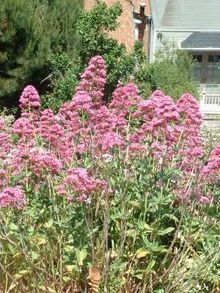Perennials
A perennial plant or perennial (Latin per, "through", annus, "year") is a plant that lives for more than two years. more...
When used as a noun, this term applies specifically to herbaceous plants, even though woody plants like shrubs and trees are also perennial in their habit.
Perennials, especially small flowering plants, grow and bloom over the spring and summer and then die back every autumn and winter, then return in the spring from their root-stock rather than seeding themselves as an annual plant does. These are known as herbaceous perennials. However, depending on the rigors of local climate, a plant that is a perennial in its native habitat, or in a milder garden, may be treated by a gardener as an annual and planted out every year, from seed, from cuttings or from divisions.
Perennial plants can be short-lived (only a few years) or they can be long-lived, as some woody plants, such as trees, have been living for over 3,000 years. They can vary in size from only a few millimeters to over 100 meters tall. They include a wide assortment of plant groups from ferns and liverworts to the highly diverse flowering plants like Orchids and Grasses.
Perennials that flower and fruit only once and then die are termed monocarpic or semelparous. However, most perennials are polycarpic, flowering over many seasons in their lifetime.
Perennials typically grow structures that allow them to adapt to living from one year to the next. These structures include bulbs, tubers, woody crowns, rhizomes plus others. They might have specialized stems or crowns that allow them to survive periods of dormancy over cold or dry seasons during the year. Annuals produce seeds to continue the species as a new generation while the growing season is suitable, and the seeds survive over the cold or dry period to begin growth when the conditions are again suitable. Many perennials, in contrast, have specialized to survive under extreme environmental conditions: some have adapted to survive hot dry conditions, or to survive under cold temperatures. Those plants tend to invest a lot of resource into their adaptations and often do not flower and set seed until after a few years of growth. Many perennials produce relatively large seeds, which can have an advantage, with larger seedlings produced after germination that can better compete with other plants or more quickly develop leaves for photosynthesis. Annuals tend to produce many more seeds per plant since they will die at the end of the growing season, while perennials are not under the same pressure to produce large numbers of seeds but can produce seeds over many years.
In warmer and more clement climates, perennials grow continuously. In seasonal climates, their growth is limited to the growing season. For example, in temperate regions a perennial plant may grow and bloom during the warm part of the year, with the foliage dying back in the winter. These plants are deciduous perennials. Regrowth is from existing stem tissue. In many parts of the world, seasonality is expressed as wet and dry periods rather than warm and cold periods. In some species, perennials retain their foliage all year round; these are evergreen perennials.
Read more at Wikipedia.org



